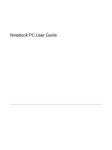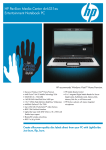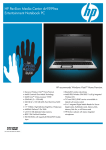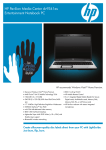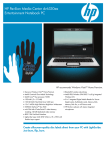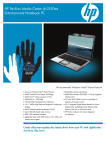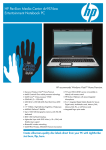Download HP CQ20 User's Manual
Transcript
Notebook Tour User Guide © Copyright 2008 Hewlett-Packard Development Company, L.P. Microsoft and Windows are U.S. registered trademarks of Microsoft Corporation. Bluetooth is a trademark owned by its proprietor and used by Hewlett-Packard Company under license. SD Logo is a trademark of its proprietor. The information contained herein is subject to change without notice. The only warranties for HP products and services are set forth in the express warranty statements accompanying such products and services. Nothing herein should be construed as constituting an additional warranty. HP shall not be liable for technical or editorial errors or omissions contained herein. First Edition: July 2008 Document Part Number: 482394-001 Safety warning notice WARNING! To reduce the possibility of heat-related injuries or of overheating the computer, do not place the computer directly on your lap or obstruct the computer air vents. Use the computer only on a hard, flat surface. Do not allow another hard surface, such as an adjoining optional printer, or a soft surface, such as pillows or rugs or clothing, to block airflow. Also, do not allow the AC adapter to contact the skin or a soft surface, such as pillows or rugs or clothing, during operation. The computer and the AC adapter comply with the user-accessible surface temperature limits defined by the International Standard for Safety of Information Technology Equipment (IEC 60950). iii iv Safety warning notice Table of contents 1 Identifying hardware 2 Components Product notice ...................................................................................................................................... 2 Top components ................................................................................................................................... 3 TouchPad ............................................................................................................................ 3 Lights ................................................................................................................................... 4 Buttons ................................................................................................................................. 5 Keys ..................................................................................................................................... 6 Front components ................................................................................................................................ 7 Right-side components ......................................................................................................................... 8 Left-side components ........................................................................................................................... 9 Bottom components ........................................................................................................................... 10 Display components ........................................................................................................................... 11 Wireless antennae (select models only) ............................................................................................. 12 Additional hardware components ....................................................................................................... 13 3 Labels Index ................................................................................................................................................................... 16 v vi 1 Identifying hardware To see a list of hardware installed in the computer, follow these steps: 1. Select Start > Computer > System Properties. 2. In the left pane, click Device Manager. You can also add hardware or modify device configurations using Device Manager. NOTE: Windows® includes the User Account Control feature to improve the security of your computer. You may be prompted for your permission or password for tasks such as installing software, running utilities, or changing Windows settings. Refer to Help and Support for more information. 1 2 Components Product notice This user guide describes features that are common to most models. Some features may not be available on your computer. 2 Chapter 2 Components Top components TouchPad Component Description (1) TouchPad* Moves the pointer and selects or activates items on the screen. (2) Left TouchPad button* Functions like the left button on an external mouse. (3) TouchPad scroll zone Scrolls up or down. (4) Right TouchPad button* Functions like the right button on an external mouse. *This table describes factory settings. To view or change TouchPad preferences, select Start > Control Panel > Hardware and Sound > Mouse. Top components 3 Lights Component Description (1) Caps lock light On: Caps lock is on. (2) Power light ● On: The computer is on. ● Blinking: The computer is in the Sleep state. ● Blinking rapidly: An AC adapter with a higher power rating should be connected. ● Off: The computer is off or in Hibernation. (3) QuickPlay light On: The QuickPlay program is launched. (4) Wireless light ● Blue: An integrated wireless device, such as a wireless local area network (WLAN) device, an HP Broadband Wireless Module, or a Bluetooth® device, is on. ● Amber: All wireless devices are off. ● Off: Computer sound is on. ● On: Computer sound is off. (5) 4 Volume mute light (6) Volume down light Blinking: The volume scroll zone is being used to decrease speaker volume. (7) Volume up light Blinking: The volume scroll zone is being used to increase speaker volume. Chapter 2 Components Buttons Component Description (1) ● When the computer is off, press the button to turn on the computer. ● When the computer is on, press the button to shut down the system. ● When the computer is in Hibernation, press the button briefly to exit Hibernation. ● When the computer is in the Sleep state, press the button briefly to exit Sleep. Power button If the computer has stopped responding and Windows® shutdown procedures are ineffective, press and hold the power button for at least 5 seconds to turn off the computer. To learn more about your power settings, select Start > Control Panel > System and Maintenance > Power Options. (2) Media button Launches the QuickPlay program. (3) Wireless button Turns the wireless feature on or off but does not establish a wireless connection. NOTE: You must set up or access a wireless network to establish a wireless connection. (4) Volume mute button Mutes and restores speaker sound. (5) Volume down button Decreases speaker sound. (6) Volume up button Increases speaker sound. Top components 5 Keys 6 Component Description (1) esc key Displays system information about your computer when pressed in combination with the fn key. (2) fn key Executes frequently used system functions when pressed in combination with a function key or the esc key. (3) Windows logo key Displays the Windows Start menu. (4) Windows applications key Displays a shortcut menu for items beneath the pointer. (5) Embedded numeric keypad keys Can be used like the keys on an external numeric keypad. (6) Function keys Execute frequently used system functions when pressed in combination with the fn key. Chapter 2 Components Front components Component Description (1) ● Blinking green: The hard drive or optical drive is being accessed. ● Amber (select models only): HP 3D DriveGuard has temporarily parked the hard drive. Drive light (2) Audio-in (microphone) jack Connects an optional computer headset microphone, stereo array microphone, or monaural microphone. (3) Audio-out (headphone) jack Produces sound when connected to optional powered stereo speakers, headphones, ear buds, a headset, or television audio. Front components 7 Right-side components Component Description (1) ExpressCard slot Supports optional ExpressCards. (2) Digital Media Slot (select models only) Supports the following optional digital card formats: ● MultiMediaCard ● MultiMedia Card Plus ● Secure Digital Memory Card ● Secure Digital High Capacity Memory Card (3) HDMI port Connects an optional video or audio device, such as a highdefinition television or any compatible digital or audio component. (4) USB ports (2) (select models only) Connect optional USB devices. (5) External monitor port Connects an external VGA monitor or projector. (6) Vent Enables airflow to cool internal components. NOTE: The computer fan starts up automatically to cool internal components and prevent overheating. It is normal for the internal fan to cycle on and off during routine operation. (7) Security cable slot Attaches an optional security cable to the computer. NOTE: The security cable is designed to act as a deterrent, but it may not prevent the computer from being mishandled or stolen. 8 Chapter 2 Components Left-side components Component Description (1) ● Amber: A battery is charging. ● Turquoise: A battery is close to full charge capacity. ● Blinking amber: A battery that is the only available power source has reached a low battery level. When the battery reaches a critical battery level, the battery light begins blinking rapidly. ● Off: If the computer is plugged into an external power source, the light turns off when all batteries in the computer are fully charged. If the computer is not plugged into an external power source, the light stays off until the battery reaches a low battery level. Battery light (2) Power connector Connects an AC adapter. (3) RJ-45 (network) jack Connects a network cable. (4) RJ-11 (modem) jack Connects a modem cable. (5) USB port Connects an optional USB device. (6) Optical drive Reads optical discs and, on select models, also writes to optical discs. Left-side components 9 Bottom components Component Description (1) Battery bay Holds the battery. (2) Battery release latch Releases the battery from the battery bay. (3) Wireless module compartment Holds a WLAN module (select models only). NOTE: To prevent an unresponsive system, replace the wireless module only with a wireless module authorized for use in the computer by the governmental agency that regulates wireless devices in your country or region. If you replace the module and then receive a warning message, remove the module to restore computer functionality, and then contact technical support through Help and Support. (4) Vents (2) Enable airflow to cool internal components. NOTE: The computer fan starts up automatically to cool internal components and prevent overheating. It is normal for the internal fan to cycle on and off during routine operation. (5) 10 Hard bay drive Chapter 2 Components Contains the hard drive and the memory module slot. Display components Component Description (1) Record sound. Internal microphones (2) (select models only) NOTE: All models have at least one internal microphone. (2) Webcam light (select models only) On: The webcam is in use. (3) Webcam (select models only) Records audio and video and captures still photographs. Display components 11 Wireless antennae (select models only) On select computer models, at least 2 antennae send and receive signals from one or more wireless devices. These antennae are not visible from the outside of the computer. NOTE: For optimal transmission, keep the areas immediately around the antennae free from obstructions. To see wireless regulatory notices, refer to the section of the Regulatory, Safety and Environmental Notices that applies to your country or region. These notices are located in Help and Support. 12 Chapter 2 Components Additional hardware components Component Description (1) Power cord* Connects an AC adapter to an AC outlet. (2) Battery* Powers the computer when the computer is not plugged into external power. (3) AC adapter Converts AC power to DC power. (4) Modem cable (select models only)* Connects the internal modem to an RJ-11 telephone jack or to a country- or region-specific modem cable adapter. (5) Country- or region-specific modem cable adapter Adapts the modem cable to a non-RJ-11 telephone jack. (select models only)* *Modem cables, modem cable adapters, batteries, and power cords vary in appearance by country or region. Additional hardware components 13 3 Labels The labels affixed to the computer provide information you may need when you troubleshoot system problems or travel internationally with the computer: ● Service tag—Provides important information including the following: ◦ Product name (1). This is the product name affixed to the front of your notebook. ◦ Serial number (s/n) (2). This is an alphanumeric number that is unique to each product. ◦ Part number/Product number (p/n) (3). This number provides specific information about the product's hardware components. The part number helps a service technician to determine what components and parts are needed. ◦ Model description (4). This is the number you use to locate documents, drivers, and support for your notebook. ◦ Warranty period (5). Describes the duration of the warranty period for this computer. Have this information available when you contact technical support. The service tag label is affixed to the bottom of the computer. 14 ● Microsoft® Certificate of Authenticity—Contains the Windows® Product Key. You may need the Product Key to update or troubleshoot the operating system. This certificate is affixed to the bottom of the computer. ● Regulatory label—Provides regulatory information about the computer. The regulatory label is affixed inside the battery bay. ● Modem approval label—Provides regulatory information about the modem and lists the agency approval markings required by some of the countries in which the modem has been approved for use. You may need this information when traveling internationally. The modem approval label is affixed inside the hard drive bay. ● Wireless certification label(s) (select models only)—Provide information about optional wireless devices and the approval markings of some of the countries in which the devices have been approved for use. An optional device may be a wireless local area network (WLAN) device or an optional Bluetooth® device. If your computer model includes one or more wireless devices, one or more certification labels are included with your computer. You may need this information when Chapter 3 Labels traveling internationally. Wireless certification labels are affixed inside the WLAN module compartment. 15 Index D digital media slot, identifying drive light, identifying 7 B battery bay 14 battery bay, identifying 10 battery light, identifying 9 battery release latch, identifying 10 battery, identifying 13 bays battery 10, 14 Bluetooth label 15 buttons power 5 QuickPlay 5 TouchPad 3 volume down 5 volume mute 5 volume up 5 wireless 5 C camera light, identifying 11 camera, identifying 11 caps lock light, identifying 4 Certificate of Authenticity label compartments memory module 10 wireless module 10 components additional hardware 13 bottom 10 display 11 16 Index keys esc 6 fn 6 function 6 keypad 6 Windows applications 6 Windows logo 6 front 7 left-side 9 right-side 8 top 3 connectors, power 9 cord, power 13 A AC adapter, identifying 13 antennae 12 applications key, Windows 6 audio-in (microphone) jack, identifying 7 audio-out (headphone) jack, identifying 7 8 E esc key, identifying 6 ExpressCard slot, identifying 8 external monitor port, identifying 8 F fn key, identifying 6 function keys, identifying 6 H hard bay drive, identifying 10 HDMI port, identifying 8 headphone (audio-out) jack 7 I internal microphones, identifying 11 14 J jacks audio-in (microphone) 7 audio-out (headphone) 7 RJ-11 (modem) 9 RJ-45 (network 9 K keypad keys, identifying 6 L labels Bluetooth 15 Microsoft Certificate of Authenticity 14 modem approval 14 regulatory 14 service tag 14 wireless certification 15 WLAN 15 latches battery release 10 lights battery 9 caps lock 4 drive 7 mute 4 power 4 QuickPlay 4 volume down 4 volume mute 4 volume up 4 webcam 11 wireless 4 M memory module compartment, identifying 10 microphone (audio-in) jack 7 microphones, internal, identifying 11 Microsoft Certificate of Authenticity label 14 modem approval label 14 modem cable, identifying 13 monitor port, external 8 mute button, identifying 5 mute light, identifying 4 O operating system Microsoft Certificate of Authenticity label 14 Product Key 14 P ports external monitor 8 HDMI 8 USB 8, 9 power button, identifying 5 power connector, identifying power cord, identifying 13 power lights, identifying 4 Product Key 14 product name and number, computer 14 T TouchPad buttons, identifying 3 TouchPad scrolling zones, identifying 3 TouchPad, identifying 3 traveling with the computer modem approval label 14 wireless certification labels 15 U USB ports, identifying 9 Q QuickPlay button, identifying 5 QuickPlay light, identifying 4 R regulatory information modem approval label 14 regulatory label 14 wireless certification labels 15 RJ-11 (modem) jack, identifying 9 RJ-45 (network) jack, identifying 9 8, 9 V vents, identifying 8, 10 volume down button, identifying 5 volume down light, identifying 4 volume mute button, identifying 5 volume mute light, identifying 4 volume up button, identifying 5 volume up light, identifying 4 W webcam light, identifying 11 webcam, identifying 11 Windows applications key, identifying 6 Windows logo key, identifying 6 wireless antennae 12 wireless button, identifying 5 wireless certification label 15 wireless light, identifying 4 wireless module compartment, identifying 10 WLAN device 15 WLAN label 15 S scrolling zones, TouchPad 3 security cable slot, identifying 8 serial number, computer 14 service tag 14 slots digital media 8 expansion memory module 10 ExpressCard 8 security cable 8 Index 17



























